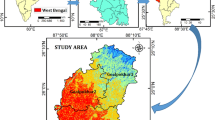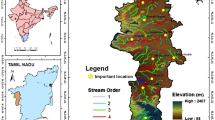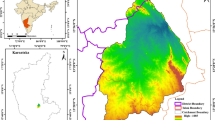Abstract
Groundwater contamination has increased in recent years due to an escalation in the use of groundwater and increasing agricultural activities. The growing demand for groundwater has improved that it is necessary to identify zones in an environment where groundwater reserves are most probable to be accessible. The present study was carried out in the Kadapa region in Andhra Pradesh in India where extreme groundwater use for irrigation mainly has caused groundwater levels to decline. An AHP approach was used to assemble a groundwater potential zones (GWPZs) map for the study area. The map was compiled using ten thematic layers including: geomorphology (GM), lineament density (LD), geology, soil, slope, land use/land cover (LULC), drainage density (DD) and pre- and post-monsoon water level fluctuations. The groundwater fluctuation data were used to verify the GWPZ map, which was then associated with agricultural reliance on groundwater. The final map obtained divided the regions into five groups. These are areas with a very poor, poor, moderate, good, and very good prospectively. The area falling in the ‘very good’ zone is about 7.61 km2 (2.59%), which encompasses major in central portions of the study area. The northeast and central portions along with average patches fall in the ‘good’ zone, which encompasses an area of 78.34 km2 (26.68%). The ‘moderate’ zone is dominant in the study area which covers an area of 123.12 km2 (40.93%). The southwestern and north-western parts of eastern and southwest and central portions of the study area are characterised as having ‘poor’ 78.05 km2 (26.58%) and ‘very poor’ 6.52 km2 (2.22%) groundwater potential zones. The groundwater potential map was finally verified using the well yield data of 39 pumping wells, and the result was found satisfactory. Together, it is possible to define a practical method for explaining the potential for groundwater accessibility which finally allows for improved development and management of groundwater sources. Since the current technique is based on logical criteria and reasoning, it may be successfully used elsewhere with minor changes. Thus, the capabilities of remote sensing and GIS in delineating different ground water potential zones have been convincingly proven in the above study, particularly in such a diversified geological setting.












Similar content being viewed by others
Data availability statement
The raw data are obtained from NRSC Bhuvan and USGS website (https://bhuvan.nrsc.gov.in/ and https://earthexplorer.usgs.gov/) which is available free of cost and the findings of this study are available from the corresponding author, upon reasonable request.
References
Adji, T. N., & Sejati, S. P. (2014). Identification of groundwater potential zones within an area with various geomorphological units by using several field parameters and a GIS approach in Kulon Progo Regency, Java Indonesia. Arabian Journal of Geosciences, 7, 161–172.
Agarwal, E., Agarwal, R., Garg, R. D., & Garg, P. K. (2013). Delineation of groundwater potential zone: an AHP/ANP approach. Journal of Earth System Science, 122, 887–898.
Arshad, A., Zhang, Z., Zhang, W., & Dilawar, A. (2020). Mapping favorable groundwater potential recharge zones using a GIS-based analytical hierarchical process and probability frequency ratio model: a case study from an agro-urban region of Pakistan. Geoscience Frontiers, 11(5), 1805–1819.
Basha, U. I., Suresh, U., Raju, G. S., Rajasekhar, M., Veeraswamy, G., & Balaji, E. (2018). Landuse and landcover analysis using remote sensing and GIS: a case study in Somavathi River, Anantapur District, Andhra Pradesh, India. Nature Environment and Pollution Technology, 17(3), 1029–1033.
Bhattacharya, S., Das, S., Das, S., Kalashetty, M., & Warghat, S. R. (2020). An integrated approach for mapping groundwater potential applying geospatial and MIF techniques in the semiarid region. Environment, Development and Sustainability. https://doi.org/10.1007/s10668-020-00593-5
Biswas, S., Mukhopadhyay, B. P., & Bera, A. (2020). Delineating groundwater potential zones of agriculture dominated landscapes using GIS based AHP techniques: a case study from Uttar Dinajpur district West Bengal. Environmental Earth Sciences, 79(12), 1–25.
Dunning, D. J., Ross, Q. E., & Merkhofer, M. W. (2000). Multiattribute utility analysis for addressing Section 316(b) of the Clean Water Act. Environmental Science and Policy, 3, 7–14.
Etikala, B., Golla, V., Li, P., & Renati, S. (2019). Deciphering groundwater potential zones using MIF technique and GIS: A study from Tirupati area, Chittoor District, Andhra Pradesh, India. Hydro Research, 1, 1–7.
Ghosh, D., Mandal, M., Karmakar, M., Banerjee, M., & Mandal, D. (2020). Application of geospatial technology for delineating groundwater potential zones in the Gandheswari watershed, West Bengal. Sustainable Water Resources Management, 6, 14. https://doi.org/10.1007/s40899-020-00372-0
Jasrotia, A. S., Bhagath, B. D., Ajay, K., & Rajesh, K. (2013). Remote sensing and GIS approach for delineation of groundwater potential and groundwater quality zones of Western Doon Valley, Uttarakhand India. Journal of the Indian Society of Remote Sensing, 41, 365–377.
Kadam, A. K., Umrikar, B. N., & Sankhua, R. N. (2020). Assessment of recharge potential zones for groundwater development and management using geospatial and MCDA technologies in semiarid region of Western India. SN Applied Sciences, 2(2), 1–11.
Kaliraj, S., Chandrasekar, N., Magesh, N.S. (2013). Identification of potential groundwater recharge zones in Vaigai upper basin, Tamil Nadu, using GIS-based analytical hierarchial process (AHP)technique. Arab. J. Geisci.
Kesana Sai Teja, Dinesh Singh Identification of Groundwater Potential Zones using Remote Sensing and GIS, Case Study: Mangalagiri Mandal ISSN: 2277–3878, Volume-7, Issue-6C2, April 2019 (IJRTE)
Khadse, G. K., Vijay, R., & Labhasetwar, P. K. (2015). Prioritization of catchments based on soil erosion using remote sensing and GIS. Environmental Monitoring and Assessment, 187(6), 1–11.
Kumar, R., & Yadav, G. S. (2015). Delineation of fracture zones in the part of Vindhyan fringe belt of Ahraura region, Mirzapur district, Uttar Pradesh, India using integrated very low frequency electromagnetic and resistivity data for groundwater exploration. Arabian Journal of Geosciences, 8(2), 727–737
Kumar, T., Gautam, A. K., & Jhariya, D. C. (2016). Multi-criteria decision analysis for planning and management of groundwater resources in Balod district, India. Environmental Earth Sciences 75(649), 1–16.
Kumar, P., Thakur, P. K., Bansod, B. K., & Debnath, S. K. (2017). Multi-criteria evaluation of hydro-geological and anthropogenic parameters for the groundwater vulnerability assessment. Environmental Monitoring and Assessment, 189(11), 1–24.
Machiwal, D., Jha, M. K., & Mal, B. C. (2011). Assessment of groundwater potential in a semi-arid region of India using remote sensing, GIS and MCDM techniques. Water Resources Management, 25(5), 1359–1386.
Magesh, N. S., Chandrasekar, N., & Soundranayagam, J. P. (2012). Delineation of groundwater potential zones in Theni district, Tamil Nadu, using remote sensing GIS and MIF Techniques. Geoscience Frontiers, 3, 189–196.
Mallick, J., Singh, C. K., Al‐Wadi, H., Ahmed, M., Rahman, A., Shashtri, S., & Mukherjee, S. (2015). Geospatial and geostatistical approach for groundwater potential zone delineation. Hydrological Processes, 29(3), 395–418.
Marhaento, H., Booij, M. J., & Hoekstra, A. Y. (2018). Hydrological response to future land-use change and climate change in a tropical catchment. Hydrological Sciences Journal, 63(9), 1368–1385.
Murmu, P., Kumar, M., Lal, D., Sonker, I., & Singh, S. K. (2019). Delineation of groundwater potential zones using geospatial techniques and analytical hierarchy process in Dumka district, Jharkhand India. Groundwater for Sustainable Development, 9, 100239.
Murugesan, V., Krishnaraj, S., Kannusamy, V., Selvaraj, G., & Subramanya, S. (2011). Groundwater potential zoning in Thirumanimuttar sub-basin Tamilnadu, India—a GIS and remote sensing approach. Geo-Spatial Information Science, 14(1), 17–26.
Nag, S. K., & Ghosh, P. (2013). Delineation of groundwater potential zone in Chhatna Block. Bankura District, West Bengal, India using remote sensing and GIS techniques. Environment and Earth Science, 70, 2115–2127.
Nag, S. K., & Ray, S. (2015). Deciphering groundwater potential zones using geospatial technology: a study in Bankura Block I and Block II, Bankura District, West Bengal. Arabian Journal for Science and Engineering, 40(1), 205–214.
Pal, S., Kundu, S., & Mahato, S. (2020). Groundwater potential zones for sustainable management plans in a river basin of India and Bangladesh. Journal of Cleaner Production, 257, 120311.
Pankaj Kumar, Srikantha Herath, Ram Avtar, Kazuhiko Takeuchi (2016) Mapping of groundwater potential zones in Killinochi area, Sri Lanka, using GIS and remote sensing techniques. Sustain. Water Resource Management, vol. 2, pp. 419–430. https://doi.org/10.1007/s40899-016-0072-5
Patra, S., Mishra, P., & Mahapatra, S. C. (2018). Delineation of groundwater potential zone for sustainable development: a case study from Ganga Alluvial Plain covering Hooghly district of India using remote sensing, geographic information system and analytic hierarchy process. Journal of Cleaner Production, 172, 2485–2502. https://doi.org/10.1016/j.jclepro.2017.11.161
Pinto, D., Shrestha, S., Babel, M. S., & Ninsawat, S. (2017). Delineation of groundwater potential zones in the Comoro watershed, Timor Leste using GIS, remote sensing and analytic hierarchy process (AHP) technique. Applied Water Science, 7(1), 503–519.
Rajasekhar, M., Raju, G. S., Raju, R. S., Ramachandra, M., & Kumar, B. P. (2018). Data on comparative studies of lineaments extraction from ASTER DEM, SRTM, and Cartosat for Jilledubanderu River basin, Anantapur district, AP, India by using remote sensing and GIS. Data in Brief, 20, 1676–1682.
Rajasekhar, M., Sudarsana Raju, G., Bramaiah, C., Deepthi, P., Amaravathi, Y., & Siddi Raju, R. (2018). Delineation of groundwater potential zones of semi-arid region of YSR Kadapa District, Andhra Pradesh, India using RS, GIS and analytic hierarchy process. Remote Sensing of Land, 2(2), 76–86.
Rajasekhar, M., Raju, G. S., Sreenivasulu, Y., & Raju, R. S. (2019). Delineation of groundwater potential zones in semi-arid region of Jilledubanderu river basin, Anantapur District, Andhra Pradesh, India using fuzzy logic, AHP and integrated fuzzy-AHP approaches. HydroResearch, 2, 97–108.
Rajasekhar, M., Gadhiraju, S. R., Kadam, A., & Bhagat, V. (2020). Identification of groundwater recharge-based potential rainwater harvesting sites for sustainable development of a semiarid region of southern India using geospatial, AHP, and SCS-CN approach. Arabian Journal of Geosciences, 13(1), 1–19.
Rajasekhar, M., Raju, G. S., & Raju, R. S. (2020). Morphometric analysis of the Jilledubanderu river basin, Anantapur District, Andhra Pradesh, India, using geospatial technologies. Groundwater for Sustainable Development, 11, 100434.
Rajaveni, S. P., Nair, I. S., & Elango, L. (2016). Evaluation of impact of climate change on seawater intrusion in a coastal aquifer by finite element modelling. Journal of Climate Change, 2(2), 111–118.
Raju, R. S., Raju, G. S., & Rajasekhar, M. (2019). Identification of groundwater potential zones in Mandavi River basin, Andhra Pradesh, India using remote sensing, GIS and MIF techniques. Hydro Research, 2, 1–11.
Saaty, T.L. (1980). The analytic hierarchy process: planning, priority setting, resource allocation. McGraw-Hill, New York.
Saaty, T.L. (1990). Decision making for leaders: the analytic hierarchy process for decisions in a complex world. RWS Publications.
Saaty, T.L. (2008). Decision making with the analytic hierarchy process. International Journal of Services Sciences 1(1), 83–98.
Saranya, T., & Saravanan, S. (2020). Groundwater potential zone mapping using analytical hierarchy process (AHP) and GIS for Kancheepuram District, Tamilnadu, India. Modeling Earth Systems and Environment, 6, 1105–1122. https://doi.org/10.1007/s40808-020-00744-7
Sarma, B., & Saraf, A. K. (2002) Study of landuse—groundwater relationship using an integrated remote sensing and GIS approach. In Proceedings of Map Asia, Asian Conference on GIS, GPS, Aerial Photography and Remote Sensing, organised by Asian Institute of Technology, Bangkok and CSDMS, New Delhi, held in Bangkok.
Savita, R. S., Mittal, H. K., Satish Kumar, U., Singh, P. K., Yadav, K. K., Jain, H. K., Mathur, S. M., & Davande, S. (2018). Delineation of groundwater potential zones using remote sensing and GIS techniques in Kanakanala Reservoir Sub watershed, Karnataka, India. International Journal of Current Microbiology and Applied Sciences. https://doi.org/10.20546/ijcmas.2018.701.030
Selvam, S., Magesh, N. S., Chidambaram, S., Rajamanickam, M., & Sashikkumar, M. C. (2015). A GIS based identification of groundwater recharge potential zones using RS and IF technique: a case study in Ottapidaram taluk, Tuticorin district. Tamil Nadu. Environmental Earth Sciences, 73(7), 3785–3799.
Shankar, M. R., & Mohan, G. (2005). A GIS based hydrogeomorphic approach for identification of site-specific artificial-recharge techniques in the Deccan Volcanic Province. Journal of Earth System Science, 114(5), 505–514.
Shailaja, G., Kadam, A. K., Gupta, G., Umrikar, B. N., & Pawar, N. J. (2018). Integrated geophysical, geospatial and multiple-criteria decision analysis techniques for delineation of groundwater potential zones in a semi-arid hard-rock aquifer in Maharashtra, India. Hydrogeology Journal, 27(2), 639–654.
Shekhar, S., & Pandey, A. C. (2015). Delineation of groundwater potential zone in hard rock terrain of India using remote sensing, geographical information system (GIS) and analytic hierarchy process (AHP) techniques. Geocarto International, 30(4), 402–421.
Singh, A. L., & Singh, V. K. (2018). Assessment of groundwater quality of Ballia district, Uttar Pradesh, India, with reference to arsenic contamination using multivariate statistical analysis. Applied Water Science, 8(3), 1–18.
Thakur, J. K., Thakur, R. K., Ramanathan, A., Kumar, M., & Singh, S. K. (2011). Arsenic contamination of groundwater in Nepal—an overview. Water, 3(1), 1–20.
Thapa, R., Gupta, S., Guin, S., & Kaur, H. (2017). Assessment of groundwater potential zones using multi-influencing factor (MIF) and GIS: a case study from Birbhum district. West Bengal. Applied Water Science, 7(7), 4117–4131.
Todd, D. K., & Mays, L. W. (2005). Groundwater Hydrology (3rd ed.). John Willey & sons.
Vergari, F., Seta, M. D., Monte, M. D., Fredi, P., & LupiaPalmieri, E. (2011). Landslide susceptibility assessment in the Upper Orcia Valley (Southern Tuscany, Italy) through conditional analysis: a contribution to the unbiased selection of causal factors. Natural Hazards and Earth System Sciences, 11(5), 1475–1497.
Vijith, H. (2007). Groundwater potential in the hard rock terrain of Western Ghats: a case study from Kottayam district, Kerala using Resourcesat (IRS-P6) data and GIS techniques. Journal of the Indian Society of Remote Sensing, 35(2), 163–171.
Waikar, M. L., & Nilawar, A. P. (2014). Identification of groundwater potential zone using remote sensing and GIS technique. International Journal of Innovative Research in Science, Engineering and Technology, 3(5), 12163–12174.
Zhu, Q., & Abdelkareem, M. (2021). Mapping groundwater potential zones using a knowledge-driven approach and GIS analysis. Water, 13(5), 579.
Zolekar, R. B., & Bhagat, V. S. (2015). Multi-criteria land suitability analysis for agriculture in hilly zone: Remote sensing and GIS approach. Computers and Electronics in Agriculture, 118, 300–321.
Acknowledgments
The authors wish to thank all who assisted in conducting this work.
Funding
The authors received no specific funding for this work.
Author information
Authors and Affiliations
Corresponding author
Ethics declarations
Conflict of interest
The authors declare that they have no conflict of interest.
Rights and permissions
About this article
Cite this article
Ramachandra, M., Babu, K.R., Kumar, B.P. et al. Deciphering groundwater potential zones using AHP and geospatial modelling approaches: a case study from YSR district, Andhra Pradesh, India. Int J Energ Water Res 7, 259–269 (2023). https://doi.org/10.1007/s42108-021-00169-7
Received:
Accepted:
Published:
Issue Date:
DOI: https://doi.org/10.1007/s42108-021-00169-7




